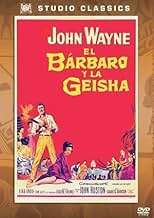IMDb-BEWERTUNG
5,7/10
2266
IHRE BEWERTUNG
Füge eine Handlung in deiner Sprache hinzuIn 1856, the first U.S. Consul General to Japan encounters the hostility of the local authorities and the love of a young geisha.In 1856, the first U.S. Consul General to Japan encounters the hostility of the local authorities and the love of a young geisha.In 1856, the first U.S. Consul General to Japan encounters the hostility of the local authorities and the love of a young geisha.
Ryuzo Demura
- Thug
- (Nicht genannt)
Kodayû Ichikawa
- Daimyo
- (Nicht genannt)
Tokujiro Iketaniuchi
- Harusha
- (Nicht genannt)
Fuji Kasai
- Lord Hotta
- (Nicht genannt)
Takeshi Kumagai
- Chamberlain
- (Nicht genannt)
Fuyukichi Maki
- Peasant
- (Nicht genannt)
Morita
- Prime Minister
- (Nicht genannt)
James Robins
- Lt. Fisher
- (Nicht genannt)
William Ross
- Soldier
- (Nicht genannt)
Norman Earl Thomson
- Captain Edmunds
- (Nicht genannt)
Hiroshi Yamato
- The Shogun
- (Nicht genannt)
Handlung
WUSSTEST DU SCHON:
- WissenswertesBased on the true story of American diplomat Townsend Harris, his time in Japan in the 1850s and 60s, and his romance with a 17-year-old geisha named Kichi. Their story is one of the most well-known folk tales in Japan. The real Harris died in New York in 1878, and the real Kichi committed suicide in Shimoda in 1892.
- PatzerAt one point, Townsend calls to his Chinese servant Sam; this was not, as some thought, a mistaken reference to an actor's real name.
- Zitate
Henry Heusken: My hat!
Townsend Harris: Well, let him have it, Henry. It doesn't fit you anyway.
- VerbindungenFeatured in Cleopatra: The Film That Changed Hollywood (2001)
Ausgewählte Rezension
Star and director are not exactly in their element throughout this period piece (set in mid-19th century Japan and based on real events) – though John Wayne gets to brawl with a dwarf/giant combination!; apparently, Huston became fascinated with the country and its culture after viewing Akira Kurosawa’s RASHOMON (1951) and Teinosuke Kinugasa’s GATE OF HELL (1953) – in fact, he obtained the services of the latter as a “script supervisor” on this one!
Still, the film is interesting in its depiction of the clash of traditions – especially involving two countries which, a little over a decade earlier, had been deadly enemies – and, in any case, Japan was a popular venue with Hollywood during this time: witness the two back-to-back Marlon Brando vehicles THE TEAHOUSE OF THE AUGUST MOON (1956) and SAYONARA (1957). The glossy production values (courtesy of Fox) make the most of the exotic locations, but the plot itself is rather melodramatic – Wayne’s initially hostile reception, an outbreak of cholera, the assassination of a supportive Japanese leader (which threatens to throw the country into Civil War), an attempt on Wayne’s own life and the failed aggressor’s subsequent seppuku (which also terminates Wayne’s subtle romance with the geisha of the title), etc.
Finally, though as I said this is one of Wayne’s most uncharacteristic films (which I had missed out on countless times in the past but was determined to catch now in commemoration of the 20th anniversary of Huston’s passing), it’s certainly not worthy of the same level of disdain as his other Asian flick – Dick Powell’s camp classic THE CONQUEROR (1956).
Still, the film is interesting in its depiction of the clash of traditions – especially involving two countries which, a little over a decade earlier, had been deadly enemies – and, in any case, Japan was a popular venue with Hollywood during this time: witness the two back-to-back Marlon Brando vehicles THE TEAHOUSE OF THE AUGUST MOON (1956) and SAYONARA (1957). The glossy production values (courtesy of Fox) make the most of the exotic locations, but the plot itself is rather melodramatic – Wayne’s initially hostile reception, an outbreak of cholera, the assassination of a supportive Japanese leader (which threatens to throw the country into Civil War), an attempt on Wayne’s own life and the failed aggressor’s subsequent seppuku (which also terminates Wayne’s subtle romance with the geisha of the title), etc.
Finally, though as I said this is one of Wayne’s most uncharacteristic films (which I had missed out on countless times in the past but was determined to catch now in commemoration of the 20th anniversary of Huston’s passing), it’s certainly not worthy of the same level of disdain as his other Asian flick – Dick Powell’s camp classic THE CONQUEROR (1956).
- Bunuel1976
- 30. Aug. 2007
- Permalink
Top-Auswahl
Melde dich zum Bewerten an und greife auf die Watchlist für personalisierte Empfehlungen zu.
- How long is The Barbarian and the Geisha?Powered by Alexa
Details
- Erscheinungsdatum
- Herkunftsland
- Sprachen
- Auch bekannt als
- The Barbarian and the Geisha
- Drehorte
- Kyōto, Japan(Nijojo Castle)
- Produktionsfirma
- Weitere beteiligte Unternehmen bei IMDbPro anzeigen
Box Office
- Budget
- 3.500.000 $ (geschätzt)
- Laufzeit1 Stunde 45 Minuten
- Seitenverhältnis
- 2.55 : 1
Zu dieser Seite beitragen
Bearbeitung vorschlagen oder fehlenden Inhalt hinzufügen



























